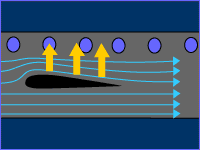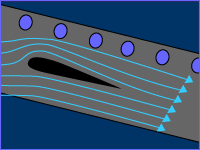 |
 |
|  This diagram showing the cross section of a wing does not fully
illustrate how a wing produces lift.
This diagram showing the cross section of a wing does not fully
illustrate how a wing produces lift.
|
The Colditz Glider
Airfoil Aerodynamics
What causes lift, that upward force that keeps flying machines aloft?
Perhaps in a textbook or in a book written for a general audience you've seen
an illustration similar to the one shown here—the kind that shows how air
flows around a wing.
In this illustration, the air divides at the leading edge of the wing, with
some of it flowing up and around the top of the wing, and some of it flowing
straight across the wing's flat bottom. The explanation that accompanies such
an illustration usually states that the air moving over the top of the wing
flows faster than the air underneath, and that this creates a situation in which
lower air pressure exists above
the wing than below it. The wing, therefore, "lifts" in the direction of lower air pressure.
The above illustration, as it turns out, is not 100 percent correct. And the
explanation, although not technically incorrect, is incomplete.
If the shape of the wing alone were responsible for creating lift, how could an
airplane flying upside down stay aloft? Wouldn't the lift from its upside-down
wings "lift" the plane right toward the ground?
What the illustration fails to show, and what the explanation leaves out, is
that for a wing to produce lift, it needs to push air down.
Newton's Third Law states that for every action, there is an equal and opposite
reaction. In the case of an airplane or glider, the action of the wings pushing
air down causes the reaction of air pushing the wings up. If you stick
your flattened hand out of the window of a fast-moving car, you can experience this
principle firsthand. If you angle your hand so that the air meets its
underside, your hand shoots upward.
 An airplane's wing produces lift when it pushes the air flowing
around it down.
An airplane's wing produces lift when it pushes the air flowing
around it down.
|
|
This does not mean that the wing's shape is unimportant. The underside of the wing can certainly deflect the
air flowing underneath down, but so can the air flowing over the top of the
wing. This is because the air tries to hug the top of the wing as it moves over
it. And after it flows beyond the wing, the downward-moving air meets the air
flowing underneath the wing, forcing it down too.
Keeping the plane aloft requires the right amount of air to be pushed down. If
the plane's flight path is level, the weight of the air pushed down is equal to
the weight of the plane. And if it's climbing, the weight of the air pushed
down is more than the weight of the plane.
|  A wing that is positioned at an angle to the oncoming wind will
produce more lift.
A wing that is positioned at an angle to the oncoming wind will
produce more lift.
|
How much air the wings push down is also determined by the plane's speed.
Fast-moving wings move a lot more air than slow-moving wings and so produce
more lift. But this doesn't mean that slow-moving wings can't be made to
produce more lift. How? The plane can be angled, relative to the air it's
flying into, to allow more of the air to hit its wings.
Now we come back to our upside-down flying plane. As long as the plane's wings
push air down, we have lift. The wings won't be working as efficiently as
possible, but if they're angled enough, the plane can continue its inverted
flight for as long as the pilot wants.
Escaping Colditz |
The Jailor's Story |
Great Escapes |
The Colditz Glider
Resources |
Transcript |
Site Map |
Nazi Prison Escape Home
Editor's Picks |
Previous Sites |
Join Us/E-mail |
TV/Web Schedule
About NOVA |
Teachers |
Site Map |
Shop |
Jobs |
Search |
To print
PBS Online |
NOVA Online |
WGBH
© | Updated January 2001
|
|
|